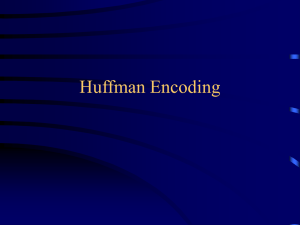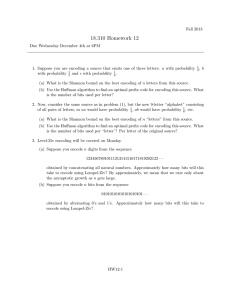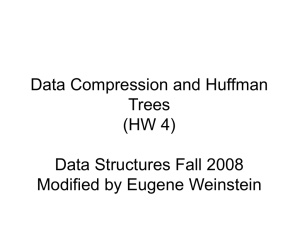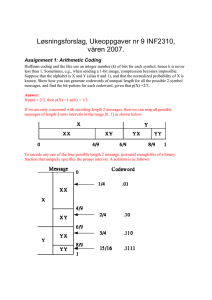Huffman Encoding 26-Jul-16
advertisement
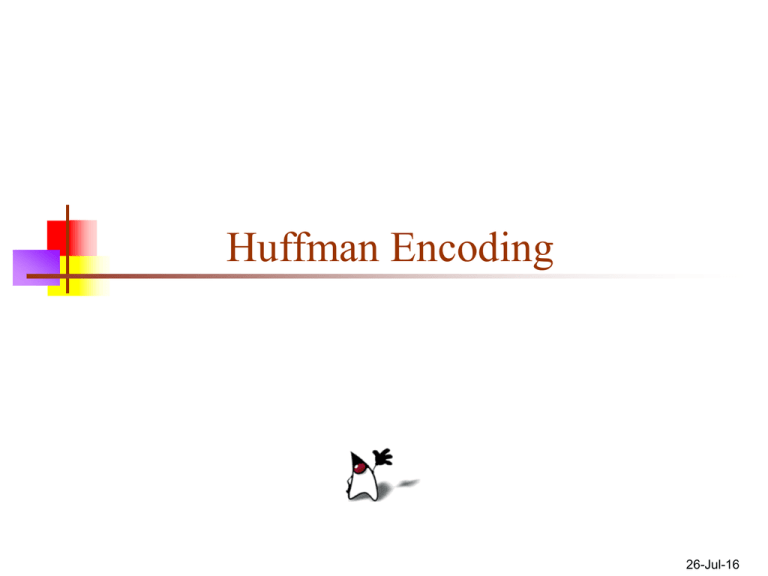
Huffman Encoding
26-Jul-16
Entropy
Entropy is a measure of information content: the
number of bits actually required to store data.
Entropy is sometimes called a measure of surprise
A highly predictable sequence contains little actual
information
A completely unpredictable sequence of n bits contains
n bits of information
Example: 11011011011011011011011011 (what’s next?)
Example: I didn’t win the lottery this week
Example: 01000001110110011010010000 (what’s next?)
Example: I just won $10 million in the lottery!!!!
Note that nothing says the information has to have any
“meaning” (whatever that is)
Actual information content
A partially predictable sequence of n bits carries
less than n bits of information
Example #1: 111110101111111100101111101100
Blocks of 3:
111110101111111100101111101100
Example #2: 101111011111110111111011111100
Unequal probabilities: p(1) = 0.75, p(0) = 0.25
Example #3: "We, the people, in order to form a..."
Unequal character probabilities: e and t are common, j
and q are uncommon
Example #4:
{we, the, people, in, order, to, ...}
Unequal word probabilities: the is very common
Fixed and variable bit widths
To encode English text, we need 26 lower case
letters, 26 upper case letters, and a handful of
punctuation
We can get by with 64 characters (6 bits) in all
Each character is therefore 6 bits wide
We can do better, provided:
Some characters are more frequent than others
Characters may be different bit widths, so that for
example, e uses only one or two bits, while x uses several
We have a way of decoding the bit stream
Must tell where each character begins and ends
Example Huffman encoding
A=0
B = 100
C = 1010
D = 1011
R = 11
ABRACADABRA = 01001101010010110100110
This is eleven letters in 23 bits
A fixed-width encoding would require 3 bits for
five different letters, or 33 bits for 11 letters
Notice that the encoded bit string can be decoded!
Why it works
In this example, A was the most common letter
In ABRACADABRA:
5 As
2 Rs
2 Bs
1C
1D
code for A is 1 bit long
code for R is 2 bits long
code for B is 3 bits long
code for C is 4 bits long
code for D is 4 bits long
Creating a Huffman encoding
For each encoding unit (letter, in this example),
associate a frequency (number of times it occurs)
Create a binary tree whose children are the encoding
units with the smallest frequencies
You can also use a percentage or a probability
The frequency of the root is the sum of the frequencies of the
leaves
Repeat this procedure until all the encoding units are in
the binary tree
Example, step I
Assume that relative frequencies are:
A: 40
B: 20
C: 10
D: 10
R: 20
(I chose simpler numbers than the real frequencies)
Smallest numbers are 10 and 10 (C and D), so connect those
Example, step II
C and D have already been used, and the new node
above them (call it C+D) has value 20
The smallest values are B, C+D, and R, all of which
have value 20
Connect any two of these; it doesn’t matter which two
Example, step III
The smallest values is R, while A and B+C+D all have
value 40
Connect R to either of the others
Example, step IV
Connect the final two nodes
Example, step V
Assign 0 to left branches, 1 to right branches
Each encoding is a path from the root
A=0
B = 100
C = 1010
D = 1011
R = 11
Each path
terminates at a
leaf
Do you see
why encoded
strings are
decodable?
Unique prefix property
A=0
B = 100
C = 1010
D = 1011
R = 11
No bit string is a prefix of any other bit string
For example, if we added E=01, then A (0) would
be a prefix of E
Similarly, if we added F=10, then it would be a
prefix of three other encodings (B=100, C=1010,
and D=1011)
The unique prefix property holds because, in a
binary tree, a leaf is not on a path to any other node
Practical considerations
It is not practical to create a Huffman encoding for
a single short string, such as ABRACADABRA
To decode it, you would need the code table
If you include the code table in the entire message, the
whole thing is bigger than just the ASCII message
Huffman encoding is practical if:
The encoded string is large relative to the code table, OR
We agree on the code table beforehand
For example, it’s easy to find a table of letter frequencies for
English (or any other alphabet-based language)
About the example
My example gave a nice, good-looking binary tree, with
no lines crossing other lines
That’s because I chose my example and numbers carefully
If you do this for real data, you can expect your drawing will
be a lot messier—that’s OK
Example:
Data compression
Huffman encoding is a simple example of data
compression: representing data in fewer bits than
it would otherwise need
A more sophisticated method is GIF (Graphics
Interchange Format) compression, for .gif files
Another is JPEG (Joint Photographic Experts
Group), for .jpg files
Unlike the others, JPEG is lossy—it loses information
Generally OK for photographs (if you don’t compress
them too much), because decompression adds “fake”
data very similar to the original
The End
